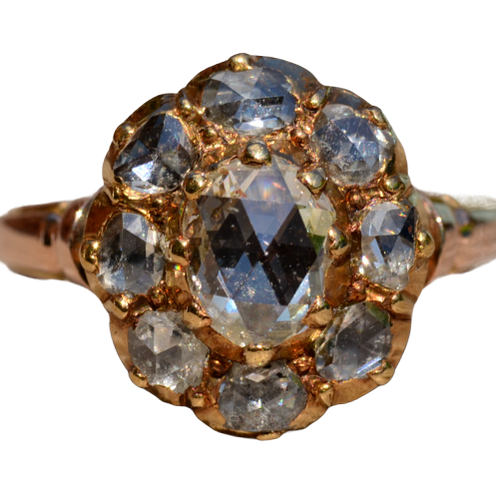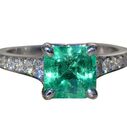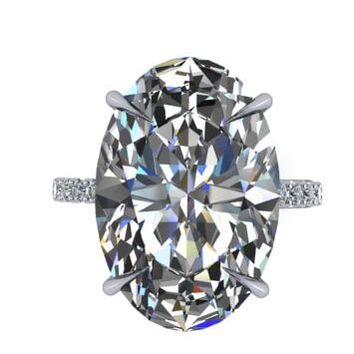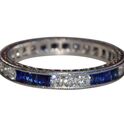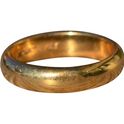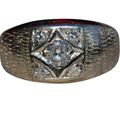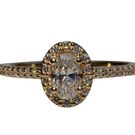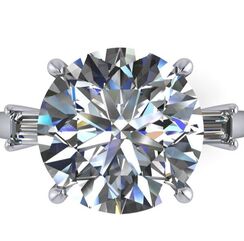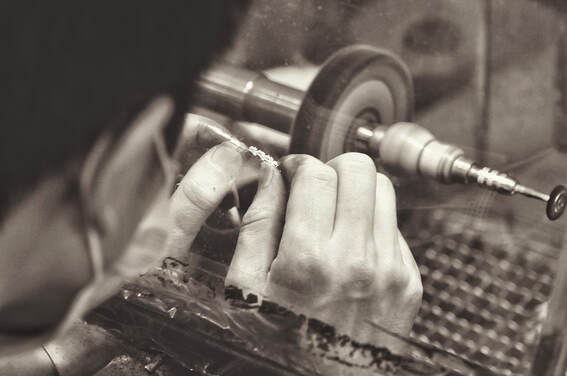|
Title: Exploring the Rich Symbolism of Irish Jewelry: Meaning Behind the Iconic Symbols
Irish jewelry has a timeless appeal, not just for its intricate craftsmanship but also for the deep symbolism infused into each piece. From ancient Celtic designs to modern interpretations, Irish jewelry reflects a rich tapestry of history, culture, and spirituality. Let's delve into the fascinating world of Irish jewelry and uncover the meanings behind its iconic symbols. **1. Claddagh Ring: Love, Loyalty, and Friendship** One of the most recognizable symbols in Irish jewelry is the Claddagh ring. This distinctive ring features a heart held by two hands with a crown on top. Each element of the Claddagh holds symbolic significance: the heart represents love, the hands symbolize friendship, and the crown signifies loyalty. The Claddagh ring originated in the Irish fishing village of Claddagh, near Galway, dating back to the 17th century. It is often given as a token of love, friendship, or loyalty, making it a popular choice for engagement rings, friendship rings, or gifts between loved ones. **2. Celtic Knotwork: Eternal Connections** Celtic knotwork is another prominent feature of Irish jewelry, renowned for its intricate, interwoven patterns that have no beginning or end. These elaborate designs symbolize eternal connections, unity, and the cyclical nature of life. The endless loops and intricate weaves of Celtic knots are believed to represent themes such as eternity, fidelity, and the interconnectedness of all things. While the exact meanings behind specific Celtic knot patterns may vary, they are often associated with concepts of love, family, and spiritual growth. **3. Shamrock: Luck and Irish Identity** The shamrock, with its distinctive three-leaf shape, holds a special place in Irish culture and symbolism. Traditionally associated with Saint Patrick, the patron saint of Ireland, the shamrock is said to have been used by Patrick to explain the concept of the Holy Trinity. In Irish jewelry, the shamrock is a symbol of luck, prosperity, and Irish identity. Wearing a shamrock pendant or charm is believed to bring good fortune and blessings. Its vibrant green leaves evoke the lush landscapes of Ireland, making it a cherished emblem of Irish heritage. **4. Tree of Life: Growth, Strength, and Wisdom** The Tree of Life is a universal symbol found in cultures around the world, including in Irish folklore and mythology. In Irish jewelry, the Tree of Life represents growth, strength, and wisdom. Its roots delve deep into the earth, while its branches reach towards the heavens, symbolizing the interconnectedness of all living things. The Tree of Life is often depicted with intricate branches and roots, teeming with symbolic meaning. It serves as a reminder of our connection to the natural world and the cyclical rhythms of life, death, and rebirth. In conclusion, Irish jewelry is not merely decorative but serves as a tangible expression of Irish culture, heritage, and spirituality. From the timeless elegance of the Claddagh ring to the intricate beauty of Celtic knotwork, each piece tells a story rich in symbolism and tradition. Whether worn as a personal talisman or given as a meaningful gift, Irish jewelry continues to captivate hearts around the world with its enduring allure. To see Irish jewelry we have take a look here: Irish Jewelry or email us for something you may be looking for!
0 Comments
When it comes to timeless elegance and natural beauty, few gems can compare to the enchanting allure of Hanadama pearls. These lustrous treasures of the sea are renowned for their exceptional quality, captivating luster, and the painstaking craftsmanship that goes into their creation. In this blog post, we delve into the fascinating world of Hanadama pearls, exploring their origin, characteristics, and why they are considered some of the most coveted pearls in the world.
The Birth of Hanadama Pearls Hanadama pearls originate from the Akoya oyster (Pinctada fucata martensii), which is primarily found in the cool coastal waters of Japan. The name "Hanadama" itself is a testament to their superior quality, as it translates to "Flower Pearls" in Japanese, symbolizing the exquisite beauty these pearls possess. Hanadama pearls are also often referred to as "Certified Akoya Pearls," as they undergo a meticulous certification process to ensure their unparalleled quality. Characteristics that Define Hanadama Pearls
To ensure that Hanadama pearls meet the highest standards, they undergo a rigorous certification process. This process involves careful examination by a team of experts who assess the pearls for luster, surface quality, shape, size, and overtones. Only those pearls that meet these strict criteria are granted the coveted Hanadama certification. The Versatility of Hanadama Pearls Hanadama pearls are incredibly versatile and can be incorporated into various jewelry designs. Whether they adorn a classic strand necklace, a pair of elegant earrings, or a statement bracelet, these pearls exude sophistication and grace, making them a perfect accessory for any occasion, from weddings to formal gatherings. Caring for Your Hanadama Pearls Proper care is essential to preserve the beauty of Hanadama pearls for generations to come. Here are some tips:
Hanadama pearls are characterized by:
All Hanadama Akoya pearls are chosen from AAA quality Akoya pearl harvests. These are the pearls that have the highest luster, Aurora effect and thickest nacre of all the pearls after harvest. The farmer or processing facility then sends their highest quality pearls to the Pearl Science Laboratory in Tokyo. The PSL is the organization responsible for testing and certifying Hanadama pearls. After the certification process, the Hanadama pearlsare sent to auction, orare sold at the large jewelry shows overseas. Buyers bring these gorgeous treasures back to western jewelry markets. Like all other Akoya pearls, Hanadama pearls are grown in the pinctada fucata martensii saltwater pearl oyster in Japan’s ocean bays. Oystersare grafted with perfectly round mother-of-pearl bead nuclei. A tiny piece of donor mantle tissue covers the bead nucleus, which helps kick-start pearl sac formation. The grafted oysters are then hung in woven baskets that are suspended from long lines while the pearls slowly grow inside. Pearl growth time is ideally 18-24 months … the longer in the water, the better from the pearl-lovers point of view, as the longer those pearls stay! Major Qualifications that MUST be Met to Qualify for Hanadama Grade:
The 5 Major Pearl Grading Attributes are:
The Ultimate Guide to Finding Trusted Estate Jewelry BuyersDo you have heirloom estate jewelry that you're ready to part with? Finding reputable buyers can be overwhelming with so many options available. You want to ensure that you receive the best value for your precious pieces and work with professionals who handle your jewelry with care. That's where our comprehensive guide comes in.
In this guide, we'll take you through the step-by-step process of finding reliable estate jewelry buyers. We cover everything from researching and vetting potential buyers to understanding appraisals and negotiating fair prices. Whether you have vintage engagement rings, antique bracelets, or rare gemstone necklaces, this guide equips you with the knowledge and tools needed to make informed decisions and find trustworthy buyers who appreciate the true value of your cherished pieces. Get ready to embark on a rewarding journey of selling your estate jewelry with confidence and ease. Understanding the Value of Estate Jewelry Before delving into finding trusted estate jewelry buyers, it's crucial to have a solid understanding of your pieces' value. Estate jewelry encompasses any previously owned jewelry, be it a family heirloom or a vintage acquisition. The value is determined by factors such as material quality, craftsmanship, age, rarity, and market demand. To get an accurate assessment, check to see if you have a previous appraisal. An appraisal WILL NOT help with the value but it does provide a detailed description, including materials used, gemstone quality, and unique features contributing to its worth. Armed with this knowledge, you can find buyers who recognize the true value of your pieces. It's important to note that sentimental and emotional value doesn't always translate into monetary value when selling estate jewelry. While some pieces hold great sentimental value to you and your family, approach the selling process with a realistic mindset. Understanding the market value helps set reasonable expectations and negotiate fair prices. Estate jewelry buyers primarily focus on quality and rarity, so presenting your jewelry in the best possible light attracts genuine buyers who appreciate its true worth. Factors to Consider when Finding Trusted Estate Jewelry Buyers When searching for trusted estate jewelry buyers, consider several factors to ensure a smooth and successful transaction. Reputation is key, so look for established and reputable professionals in the industry. Check online reviews, testimonials, and ratings to gauge their track record and customer satisfaction. Experience and expertise in dealing with estate jewelry are crucial. Experienced buyers possess deep market knowledge and accurately assess the value of your pieces. Transparency and good communication are essential for building trust and ensuring a fair transaction. Also, consider the buyer's location and reach. If you prefer in-person sales, find local buyers. If open to online sales, look for buyers with a wide reach and a strong online presence. One of the advantages of working with us is that we have international clientele so our reach is further allowing us to pay more than most local dealers. Researching Reputable Estate Jewelry Buyers Once you've identified the factors to consider, dive into the research process. Create a list of potential buyers based on reputation, experience, and transparency. Utilize search engines, review websites, and social media platforms to gather information about each buyer. Check their websites or online marketplaces to see their inventory and services. Consider certifications and affiliations as indicators of credibility and ethical practices. Seek recommendations from your network or local jewelry associations. Word-of-mouth referrals are valuable in finding trustworthy buyers with a proven track record. Questions to Ask Estate Jewelry Buyers Engage with potential buyers and ask questions to gather more information and make an informed decision. Prepare a list of questions for each buyer during initial interactions. Some essential questions include:
Evaluating Offers from Estate Jewelry Buyers Consider the buyers reputation, experience, transparency, and terms of the offers. Look for explanations and justifications, demonstrating professionalism and fair pricing. Tips for a Smooth Transaction with Estate Jewelry Buyers
Selling Estate Jewelry Online vs. In-Person Decide between selling estate jewelry online or in-person is based on personal preferences and circumstances. Selling online offers convenience and a potentially wider pool of buyers, reaching a global audience. However, it carries risks such as fraudulent buyers or misrepresentation. Selling in-person allows direct interaction, enhancing trust and transparency however often times these buyers do not have the knowledge, global interaction, or clientele limiting their offer potential. Consider comfort level, jewelry value and rarity, and personal preferences to choose between online and in-person selling. Should you elect to ship items work with professionals. Common Scams to Watch Out for When Selling Estate Jewelry Be aware of common scams and take necessary precautions to protect yourself and your jewelry:
Conclusion: Finding the Right Buyer for Your Estate Jewelry Selling estate jewelry can be emotional and challenging, but with the right knowledge and tools, you can find trusted buyers who appreciate its value. Consider important factors and research reputable buyers. Sell your estate jewelry with confidence when dealing with a qualified estate jewelry buyer. We are happy to help should you need assistance. Learn about our qualifications here Learn about the process here Introduction: Philadelphia, the historic city known for its rich culture and vibrant arts scene, has been home to numerous talented jewelers who have left an indelible mark on the world of fine jewelry. From exquisite craftsmanship to innovative designs, Philadelphia has been a hub of creativity for jewelry enthusiasts. In this blog post, we will explore some of the famous Philadelphia jewelers who have made significant contributions to the industry.
Trabert & Hoeffer was a renowned American jewelry firm that made a significant impact on the world of fine jewelry during the early to mid-20th century. With its collaboration with the prestigious French jewelry house Mauboussin, Trabert & Hoeffer-Mauboussin, the company created exceptional pieces that captured the attention of the elite and reflected the glamour and sophistication of the era. In this blog post, we will delve into the rich history of Trabert & Hoeffer, exploring their craftsmanship, signature styles, and enduring legacy. A Legacy of Excellence: Trabert & Hoeffer was founded in 1890 in New York City by Gustav Trabert and Emil Hoeffer, both skilled jewelers known for their attention to detail and superb craftsmanship. The firm quickly gained a reputation for creating exquisite jewelry that showcased their exceptional artistry and fine design sensibilities. Their commitment to quality and innovation set them apart in the highly competitive world of jewelry. Collaboration with Mauboussin: In 1925, Trabert & Hoeffer formed a collaboration with the prestigious French jewelry house Mauboussin, leading to the establishment of Trabert & Hoeffer-Mauboussin. This partnership combined the technical expertise of Trabert & Hoeffer with the timeless elegance and refined craftsmanship of Mauboussin, resulting in the creation of breathtaking jewelry pieces. Design Aesthetics: Trabert & Hoeffer-Mauboussin pieces encompassed a range of styles, reflecting the evolving tastes of the era. Their jewelry incorporated elements of Art Deco, Art Nouveau, and Retro designs, with a focus on clean lines, geometric forms, and intricate metalwork. The use of vibrant gemstones, such as diamonds, emeralds, sapphires, and rubies, added a captivating allure to their creations. Elite Clientele: Trabert & Hoeffer-Mauboussin quickly garnered a prestigious clientele, including royalty, Hollywood celebrities, and prominent socialites of the time. Their exquisite pieces adorned the wrists, necks, and fingers of notable figures such as Marlene Dietrich, Gloria Swanson, and the Duchess of Windsor. The brand's jewelry became a symbol of elegance, sophistication, and luxury. Enduring Legacy: While Trabert & Hoeffer-Mauboussin ceased operations in 1941 due to the outbreak of World War II and the subsequent challenges faced by the jewelry industry, their legacy continues to captivate collectors and enthusiasts. Their meticulously crafted jewelry pieces are highly sought after and treasured as valuable examples of the exquisite craftsmanship and timeless beauty of the era. Collecting Trabert & Hoeffer-Mauboussin: For those passionate about fine jewelry and the legacy of Trabert & Hoeffer-Mauboussin, collecting their pieces can be a rewarding endeavor. Auction houses, reputable antique jewelry dealers, and specialized collectors' events are great sources for finding authentic Trabert & Hoeffer-Mauboussin jewelry. Authenticity and provenance verification are crucial when acquiring these pieces to ensure their value and quality. In conclusion, Trabert & Hoeffer-Mauboussin remains an iconic name in the world of fine jewelry. Their collaboration with Mauboussin and their commitment to exquisite craftsmanship and design excellence solidified their place in jewelry history. The legacy of Trabert & Hoeffer-Mauboussin lives on through their timeless creations, which continue to inspire and delight jewelry connoisseurs around the world. WE ARE ALWAYS INTERESTED IN ACQUIRING TRABERT & HOEFFER - MAUBOUSSIN JEWELRY!Introduction: The Art Deco period, spanning the 1920s and 1930s, was a time of bold creativity and innovation in various artistic fields, including architecture, fashion, and, of course, jewelry design. This captivating era was shaped by a series of influential events that left an indelible mark on the aesthetics and style of Art Deco jewelry. Let's explore some key events and their profound impact on this distinctive era of design.
Title: The Influential Events of the Art Deco Era on Jewelry Design Introduction: The Art Deco period, spanning the 1920s and 1930s, was a time of bold creativity and innovation in various artistic fields, including architecture, fashion, and, of course, jewelry design. This captivating era was shaped by a series of influential events that left an indelible mark on the aesthetics and style of Art Deco jewelry. Let's explore some key events and their profound impact on this distinctive era of design.
Jewelry has been an integral part of human culture for centuries. From ancient civilizations to modern times, people have adorned themselves with beautiful ornaments as a means of self-expression and personal style. While traditional jewelry pieces are often cherished and passed down through generations, a new trend is emerging - permanent jewelry. This innovative approach to adornment offers a unique and lasting way to showcase individuality and enhance personal aesthetics. In this blog post, we will explore the concept of permanent jewelry and the reasons why it is gaining popularity in today's fashion landscape.
Unveiling Permanent Jewelry: Permanent jewelry, as the name suggests, refers to jewelry that is designed to be worn permanently on the body. Unlike traditional jewelry pieces that are removed and put back on daily, permanent jewelry is inserted or implanted into the skin, becoming a permanent part of the wearer's body. This form of body modification can take various forms, such as dermal piercings, microdermal implants, or even subdermal implants. These techniques involve placing jewelry under the skin, which creates a striking and unique aesthetic. Reasons for Choosing Permanent Jewelry:
While permanent jewelry requires less maintenance compared to traditional pieces, proper care is still crucial to ensure its longevity and prevent complications. Here are a few tips to keep in mind:
Permanent jewelry offers a fascinating and innovative way to celebrate individuality, enhance aesthetics, and embrace a unique form of self-expression. With its lasting appeal, minimal maintenance, and ability to stand the test of time, permanent jewelry is gaining popularity among those who crave something distinctive and unforgettable. Whether you decide on a permanent bracelet or other piece we can help! In the realm of jewelry design, innovation often takes center stage as designers strive to create unique and captivating pieces. Among the many groundbreaking techniques that have emerged, the invisible gemstone setting stands out as a true marvel of ingenuity. This revolutionary method allows gemstones to seemingly float on the surface of a piece, creating a stunning display that accentuates the stones' brilliance and elevates the overall aesthetic. In this blog post, we will explore the fascinating history of the invisible gemstone setting and shed light on its mysterious inventor.
Origins of the Invisible Gemstone Setting: The invisible gemstone setting made its dazzling debut in the early 20th century, capturing the attention of both jewelry enthusiasts and designers alike. The exact origins of this technique are somewhat ambiguous, as multiple jewelers and jewelry houses claim credit for its invention. However, one name that often surfaces in discussions of the invisible setting is that of French jewelry house Van Cleef & Arpels. Van Cleef & Arpels and the Invisible Setting: Renowned for their exquisite craftsmanship and innovative designs, Van Cleef & Arpels has long been associated with pushing the boundaries of jewelry creation. It is widely believed that the invisible gemstone setting technique was developed by Van Cleef & Arpels in the 1930s. The jewelry house introduced this groundbreaking technique to create unique and striking pieces that showcased gemstones in a way never seen before. The Invisible Gemstone Setting Technique: The invisible gemstone setting technique involves securing gemstones, typically small diamonds, within a framework that is concealed beneath the surface of the jewelry piece. Instead of relying on prongs or bezels to hold the stones in place, a grid-like structure is created using fine wires or metal rails. These supports are meticulously crafted to ensure that the gemstones fit perfectly, creating a seamless and uninterrupted surface of brilliance. The result is a mesmerizing display where the gemstones appear to float magically, with no visible metal obstructing their brilliance. This captivating illusion enhances the stones' sparkle, as light is able to pass through the gemstones from multiple angles, resulting in a breathtaking display of radiance. The Evolution of the Invisible Gemstone Setting: Since its inception, the invisible gemstone setting technique has continued to evolve and inspire jewelry designers worldwide. Advancements in technology and the expertise of skilled artisans have allowed for even more intricate and complex designs. Today, the invisible setting is no longer limited to diamonds but is used with a wide range of gemstones, including sapphires, rubies, and emeralds, allowing for a myriad of creative possibilities. Caring for Invisible Gemstone-Set Jewelry: While the invisible gemstone setting is an impressive technique, it does require careful handling and maintenance to preserve its beauty. Here are a few tips to ensure the longevity of your invisible gemstone-set jewelry:
The invisible gemstone setting remains a testament to the innovation and craftsmanship within the world of jewelry design. While its exact origins may be shrouded in mystery, the technique's impact is undeniable. From Van Cleef & Arpels to numerous contemporary designers, the invisible gemstone setting continues to captivate jewelry enthusiasts with its breathtaking illusion White gold is a popular and valuable alloy that has been used in jewelry and other decorative items for centuries. This metal is an alloy of gold and one or more white metals, such as nickel, palladium, silver, and even platinum. In this blog post, we will explore the origin and history of the invention of white gold, including both European and American patents.
The Origin of White Gold White gold is believed to have originated in the early 19th century. At that time, jewelers were looking for a way to create a metal that had the appearance of platinum but was more affordable. They experimented with various alloys, including mixing gold with nickel, silver, and palladium. One of the first mentions of white gold is in a French publication called "L'Art du Bijoutier" (The Art of the Jeweler), which was published in 1823. The author, Louis-Nicolas Vauquelin, describes an alloy made from gold and platinum that was used to create white gold. European Patents for White Gold In Europe, the first patent for a white metal yet not necessarily known as white gold was granted to a German chemist named Carl Louis Ullmann in 1912. Ullmann's patent described an alloy made from gold, platinum, and palladium. The resulting metal was a white color, durable, and malleable, making it ideal for use in jewelry. That being said it seems many other jewelers in Germany had already been exploring and creating pieces in white gold and sharing their knowledge with jewelers in other European countries as well as the United States. Another notable European patent for white gold was granted to the French company Cartier in 1929. Cartier's patent described an alloy made from gold and palladium that was used to create a new type of white gold that was both durable and had a brighter color than previous alloys. American Patents for White Gold In the United States, the first patent for white gold was granted Karl Gustav and Paul Richter filed their patent on April 30th 1913 (drew up the document on April 14th) submitted their paperwork for a white gold patent which officially became know as white gold. The patent was granted on 12/28/15 In the years that followed, other American inventors were granted patents for various types of white gold alloys. For example, in 1924, a patent was granted to a chemist named Edwin W. De Rochemont for an alloy made from gold, nickel, and zinc. This alloy was used to create a white gold that was durable and had a bright color. Others include Belias, Jabel etc. Conclusion In conclusion, white gold has a rich history that spans continents. The origin of white gold can be traced back to the early 19th century, when jewelers were looking for a more affordable alternative to platinum. Since then, various alloys have been developed, resulting in the creation of white gold as we know it today. Both European and American inventors have played a significant role in the development of white gold, with numerous patents being granted for different types of alloys over the years. Black Hills Gold Jewelry is a unique and distinctive style of jewelry that originated in the Black Hills region of South Dakota in the late 1800s. This jewelry is known for its intricate designs and use of different colored golds, which give it a striking appearance. In this blog post, we will explore the history of Black Hills Gold Jewelry and how it has evolved over the years.
The Beginnings of Black Hills Gold Jewelry The story of Black Hills Gold Jewelry begins in 1876, when gold was discovered in the Black Hills region of South Dakota. This led to a gold rush, and soon many people were moving to the area in search of their fortune. Among them were two European immigrants, Henri LeBeau and S.T. Butler, who were both skilled goldsmiths. LeBeau and Butler started making jewelry in a small shop in Deadwood, South Dakota, using the gold they found in the area. They soon became known for their unique style, which featured intricate designs and the use of different colored golds, including pink and green. This style became known as Black Hills Gold Jewelry, and it quickly gained popularity throughout the region. The Rise of Black Hills Gold Jewelry As the popularity of Black Hills Gold Jewelry grew, more and more jewelry makers began to adopt the style. However, in 1904, LeBeau and Butler's shop burned down, and they were forced to close. This led to a decline in the production of Black Hills Gold Jewelry, but it was not the end of the story. In the 1930s, a man named Ivan Landstrom started a jewelry company in Rapid City, South Dakota, and he began producing Black Hills Gold Jewelry in large quantities. His company, Landstrom's Original Black Hills Gold Creations, became one of the largest producers of Black Hills Gold Jewelry in the world, and it is still in business today. Evolution of Black Hills Gold Jewelry Over the years, Black Hills Gold Jewelry has evolved to include many different designs and styles. While the classic designs featuring grape leaves and clusters of grapes are still popular, there are now many other designs available, including hearts, crosses, and even motorcycles. In addition, Black Hills Gold Jewelry is now made using modern technology, including computer-aided design and manufacturing processes. This has allowed jewelry makers to create even more intricate designs and to produce pieces more efficiently. Conclusion Black Hills Gold Jewelry is a unique and beautiful style of jewelry that has a rich history dating back to the gold rush of the late 1800s. From the early days of Henri LeBeau and S.T. Butler to the modern era of computer-aided design and manufacturing, this jewelry has evolved and grown in popularity over the years. Today, it is still a beloved style of jewelry that is treasured by many people around the world. |
-
Shop
- Custom
- Sell To Us
-
Services
- Appraisal Services >
- Schedule Consultation
- Custom Jewelry Design
- Recreating an Heirloom
- Jewelry Repair
- Jewelry Restoration
- Timepiece Repair
- Diamond Cutting and Gemstone Repair
- Searching for Something? >
- Jewelry Rental
- Insurance Replacement
- Private Collection Management
- Layaway
- Consignment
- Wish List
- Wholesale Inquiries >
-
The Brand
- Contact
COMPLIMENTARY SHIPPING.
NO HASSLE RETURNS
NO HASSLE RETURNS
ABOUT VBS |
LEARN WITH US |
OUR HISTORY
|
JEWELRY SCHOOL
Get the latest news and info


|
FREE EXPEDITED SHIPPING ON ALL ORDERS
ABOUT |
|
© COPYRIGHT 2017-2023. ALL RIGHTS RESERVED. All trademarked names, brands, models, logos, images, and graphics are the sole property of their respective trademark owners and copyright and credit to their respective owners. Timberbrook Capital, Velvet Box Society, including this website, its owners, employees, operators, and developers, are not affiliated with, endorsed by, or authorized retailers of any watch or jewelry brand manufacturer or any of their subsidiaries. By browsing, purchasing, or referencing our site for any reason, the user agrees to release and hold harmless Timberbrook Capital, Velvet Box Society, its affiliates, owners, operators, developers, and employees from any and all claims, liabilities, damages, and expenses, including but not limited to, any direct, indirect, incidental, or consequential losses arising from or in connection with the use of this site or any products or services purchased through this site.
